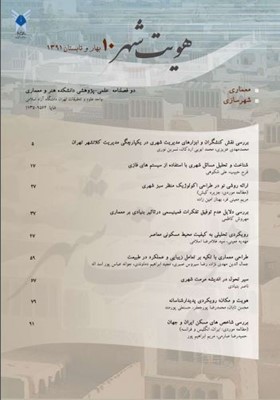ارائه روشی نو در طراحی اکولوژیک منظر سبز شهری(مطالعه موردی: جزیره کیش)
محورهای موضوعی : معماریمریم معینی فر 1 , بهناز امین زاده 2
1 - استادیار/عضو هیئت علمی گروه شهرسازی دانشگاه آزاد اسلامی قزوین
2 - دانشیار دانشگاه تهران، دانشکده شهرسازی، دانشکده هنرهای زیبا، تهران، ایران
کلید واژه: Methodology, روش شناسی, Landscape Ecology, طراحی منظر شهری, اکولوژی منظر, تحلیل سازگاری سرزمین اکولوژیک, Urban landscape design, Ecological land suitability analysis,
چکیده مقاله :
این تحقیق در قالب رویکرد اکولوژى منظر و با هدف ایجاد روشى در مکانیابی و بهسازی فضای سبز شهری انجام شده است. پس از بررسى و نقد روش هاى متداول مرتبط با موضوع و نیز بررسى اصول اکولوژی منظر به عنوان دانشى جدید در طراحى منظر شهرها ، روشى پیشنهاد شده است که مى تواند با توجه به لزوم ارتقاء کیفیت اکولوژیکی سامانه های زیستی بکار رود. تاکید داشته و شامل مراحل GIS,AHP، روش پیشنهادى "تحلیل سازگارى سرزمین اکولوژیک"، بر مطالعات سازگارى سرزمین مختلفى مى باشدکه در تحقیق معرفى شده است. جهت حصول به هدف تحقیق، روش پیشنهادى در جزیره کیش بکار گرفته شده است. یافته هاى تحقیق به صورت نقشه های سازگاری سرزمین استنتاج گردیده و کارایی روش با استفاده ازمعیارهای کیفی مورد بررسى قرار گرفته است. نتایج نشان مى دهد این روش در شرایط همسان قابل تعمیم بوده و در شرایط غیر همسان با تغییرات جزیی قابل استفاده است.
Cities are places for diverse hierarchies of natural inhabitants, and thus designing their ecological landscapes is a complex process. Landscape design is more important than form creating. Landscape ecology is a science of dynamic reactions between nature and society. Disturbance in urban landscape may cause simplification of landscape system resulted in degradation of life quality in living areas. Therefore urban development without consideration on ecological process will damage ecosystems in urban and regional scales. A good ecological design in built areas can improve ecological functions of the whole system. In this study, the application of landscape ecology together with land compatibility has been studied. The result is creating an efficient method in ecological design of urban green spaces. Urban green spaces are the most important parts of urban ecosystems, providing many social and environmental services and promoting the quality of living conditions in cities. The application of landscape ecology in urban design and consideration of urban green spaces as green networks or green infrastructures help to improve the quality of natural areas in cities. It seems that determination of an optimal method in urban landscape and green space design based on landscape ecology principles is a necessary task for landscape and urban designers. Also, recognition and introducing the interdisciplinary method in green landscape design results in positive ecological function and provides a basis for sustainability. The Kish island is selected as a case study because of its ecological sensitiveness, rapid growth development of tourism, and demand for green spaces. The main objectives of this research are as follows: a) creating a method for designing ecological urban green spaces, and b) zoning for developing, conserving or rehabilitating of green spaces in Kish island. To do this, reviewing existing ecological theories and methods and comparison of existing methods in landscape ecology are applied. The proposed method which has been nominated Ecological Land Suitability Analysis (ELSA) is based on land suitability analysis and landscape ecology principles, using GIS VER 9.2, and AHP techniques. The process of using the method is as follows: 1-Explaining of effective criteria in selection of green areas and their priorities; 2-Determination of criteria values; 3- Providing spatial layers of the selected criteria; 4- Classification of layers based on their special purpose; 5-Quantifying of quality classes using Phasy values; 6-Applying AHP weight and quantitative values in layers and determination of final weight layers; 7- Changing spatial layers from vector to raster; 8- Overlaying the spatial layers; 9-Preparing of land compatibility and suitability map; 10-Extraction of unvalued layers from total spatial layers; 11-Final layer classification and evaluation of different outputs. 12- Zoning the urban green areas in Kish Island. Results have been shown in land suitability GIS maps. The efficiency of the proposed method has been proved, using quality comparative criteria including: comprehensiveness, clearness, completeness, and flexibility, reliability, efficiency, easiness, generalizing, rapidity, necessary technology, being up to date, and fitness with the principles of theory making. It was concluded that, this method (ELSA) could be generalized in the same environmental conditions.
_||_


